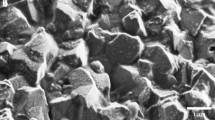Summary
Workers of the tropical ant tribes Basicerotini and Stegomyrmecini possess two dominant forms of setae on the dorsal surfaces of the body and outer surfaces of the legs: longer “brush” hairs with splintered distal ends, and shorter “holding” hairs that vary among species from plumose to blade-shaped or filiform. The two usually but not invariably occur together to create a double layer. The brush hairs evidently scrape or otherwise capture fine particles of soil, while the holding hairs help to keep them in place next to the surface exoskeleton. As the worker ages, the soil accumulates as a thin, mud-like layer, greatly enhancing the overall camouflage of the body. The material appears to be primarily or entirely exogenous; no special secretory cells were found (in Basiceros manni, studied for this purpose) that might contribute cryptically colored chemicals or adhesive substances to hold the soil in place.
Similar content being viewed by others
References
Brown WL (1974) A supplement to the revision of the ant genus Basiceros (Hymenoptera: Formicidae). J New York Ent Soc 82:131–140
Brown WL (1980) Protalaridris genus nov. (Insecta: Hymenoptera: Formicidae: Myrmicinae: Basicerotini). Pilot Register of Zoology, Cornell University, Ithaca, NY 36:1–2
Brown WL, Kempf WW (1960) A world revision of the ant tribe Basicerotini. Studia Ent, Rio de Janeiro 3:161–250
Maschwitz U, Koob K, Schildknecht H (1970) Ein Beitrag zur Funktion der Metapleuraldrüse der Ameisen. J Ins Physiol 16:387–404
Rathmayer W (1962) Methylmethacrylat als Einbettungsmedium für Insekten. Experientia (Basel) 18:47–48
Wilson EO (1957) Feeding behavior in the ant Rhopalothrix biroi Szabó. Psyche (Cambridge) 63:21–23
Wilson EO, Brown WL (1984) Behavior of the cryptobiotic predaceous ant Eurhopalothrix heliscata, n. sp. (Hymenoptera: Formicidae: Basicerotini). Ins Soc 31:408–428
Wilson EO, Hölldobler B (1986) Ecology and behavior of the Neotropical cryptobiotic ant Basiceros manni (Hymenoptera: Formicidae: Basicerotini). Ins Soc (in press)
Author information
Authors and Affiliations
Rights and permissions
About this article
Cite this article
Hölldobler, B., Wilson, E.O. Soil-binding pilosity and camouflage in ants of the tribes Basicerotini and Stegomyrmecini (Hymenoptera, Formicidae). Zoomorphology 106, 12–20 (1986). https://doi.org/10.1007/BF00311942
Received:
Issue Date:
DOI: https://doi.org/10.1007/BF00311942




